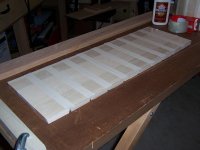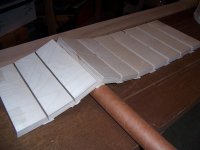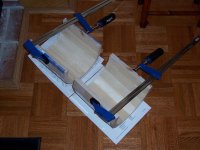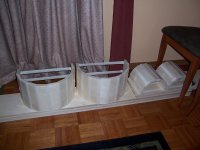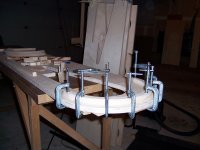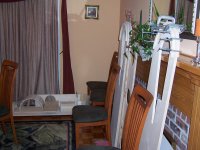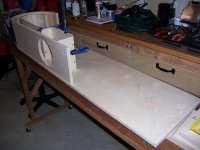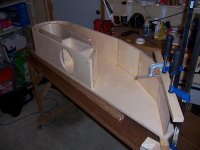I was not sure where to post this question, but hope the full range fans might have some good input to share.
I want to build two little enclosures using the Audience A3 inch full range drivers and they will be dedicated to classical guitar recordings. I also want to build a graphic equalizer (6 or 8 bands) and want to know if having an equalizer contradicts what I want to accomplish by using a full range driver.
What are your thoughts?
Thank you,
Michael Speaker
(my last project was the Hedlund horn here:
http://www.diyaudio.com/forums/full-range/70522-my-hedlund-horn-fe208esigma.html)
I want to build two little enclosures using the Audience A3 inch full range drivers and they will be dedicated to classical guitar recordings. I also want to build a graphic equalizer (6 or 8 bands) and want to know if having an equalizer contradicts what I want to accomplish by using a full range driver.
What are your thoughts?
Thank you,
Michael Speaker
(my last project was the Hedlund horn here:
http://www.diyaudio.com/forums/full-range/70522-my-hedlund-horn-fe208esigma.html)
Last edited:
I was not sure where to post this question, but hope the full range fans might have some good input to share.
I want to build two little enclosures using the Audience A3 inch full range drivers and they will be dedicated to classical guitar recordings. I also want to build a graphic equalizer (6 or 8 bands) and want to know if having an equalizer contradicts what I want to accomplish by using a full range driver.
What are your thoughts?
Thank you,
Michael Speaker
(my last project was the Hedlund horn here:
http://www.diyaudio.com/forums/full-range/70522-my-hedlund-horn-fe208esigma.html)
SACRILEGE!!!
...cool last name btw. May I offer to purchase it?
those Hedlund's look spectacular...
Last edited:
I also want to build a graphic equalizer (6 or 8 bands) and want to know if having an equalizer contradicts what I want to accomplish by using a full range driver.
What? You think you should have no tone controls? Perhaps do without a volume control too?
No. The primary advantages of FR drivers are the sound staging, the simplicity and ease of driving and the efficiency.
A certain kind of purist might think you were doing something wrong.
I have a pair of FR speakers running from a Sonic Impact amp driven through the TV by a DVD/DTV receiver. They're used for music too, you can plug in a USB stick or play CDs. The TV has a graphic EQ in the onscreen menu, I have it set to knock back the higher frequencies progressively. It's a definite improvement to running the system flat, we don't fiddle with the settings.
TVs are quite useful like that, it has a subwoofer output that I've been meaning to try, I just need a cloak of invisibility to get this ugly black box past my wife.
w
the a3 has a rising response. Audience uses 4 in a vertical array with no eq.............
Eq certainly helps bass, but modulation distortion catchs up really fast. It is usefull for baffle step, but at the end of the day, you are limited by cone area / music / and distance from the speakers. Dual 4" 4mm xmax with eq doesn't cut the mustard for me listening to blues traveller 12' away. It sounded strained and distorted.
The a3's arn't cheap but have double the usable xmax. For me, big whup, I'd rather use a larger area driver (such as Alpair or Tang band, maybe fostex).
Oh yea, and eq isn't transparant. You give some, you lose some.
Norman
Eq certainly helps bass, but modulation distortion catchs up really fast. It is usefull for baffle step, but at the end of the day, you are limited by cone area / music / and distance from the speakers. Dual 4" 4mm xmax with eq doesn't cut the mustard for me listening to blues traveller 12' away. It sounded strained and distorted.
The a3's arn't cheap but have double the usable xmax. For me, big whup, I'd rather use a larger area driver (such as Alpair or Tang band, maybe fostex).
Oh yea, and eq isn't transparant. You give some, you lose some.
Norman
At the risk of sounding like a broken record, why not try a MiniDSP solution? I am using one to aid my enclosure research and it sounds great.
Yes, every additional 'stage' introduces its own issues and some of its own flavour. If you don't need it, don't use it. Active EQ does do away with the need for passive BSC, however.
I would be very surprised if you could buy or make a good quality, good sounding analogue EQ for anything like the price, and you still don't get the incredible versatility of all that DSP goodness.
Just the steep HPF to limit excursion, BSC (if needed) and broad response tailoring are easily implemented:- my experience is that the SQ improvements that result far outweigh the (for me) barely audible signal degradation of the device itself.
YMMV
Yes, every additional 'stage' introduces its own issues and some of its own flavour. If you don't need it, don't use it. Active EQ does do away with the need for passive BSC, however.
I would be very surprised if you could buy or make a good quality, good sounding analogue EQ for anything like the price, and you still don't get the incredible versatility of all that DSP goodness.
Just the steep HPF to limit excursion, BSC (if needed) and broad response tailoring are easily implemented:- my experience is that the SQ improvements that result far outweigh the (for me) barely audible signal degradation of the device itself.
YMMV
At the risk of sounding like a broken record, why not try a MiniDSP solution? I am using one to aid my enclosure research and it sounds great.
Yes, every additional 'stage' introduces its own issues and some of its own flavour. If you don't need it, don't use it. Active EQ does do away with the need for passive BSC, however.
I would be very surprised if you could buy or make a good quality, good sounding analogue EQ for anything like the price, and you still don't get the incredible versatility of all that DSP goodness.
Just the steep HPF to limit excursion, BSC (if needed) and broad response tailoring are easily implemented:- my experience is that the SQ improvements that result far outweigh the (for me) barely audible signal degradation of the device itself.
YMMV
Came here to offer minidsp advice as well, if you were to build an analog version of just the equalizers (parametric + variable slopes and other goodies) at the same quality it would cost a lot of time and money to get similar results.
Mindsp with full range + woofer is great as well
Before I go into a long explanation, are you willing to use a computer front end or are you comitted to vinyl?
Bob, I will record myself playing classical guitar (will use microphones), then will burn CD's and play them in the CD player. I was thinking some equalization might help balance the guitar tones, just in case. Maybe no need to do any adjustments.
Will reply to the others a bit later.
Thanks,
Michael
Bob, I will record myself playing classical guitar (will use microphones), then will burn CD's and play them in the CD player. I was thinking some equalization might help balance the guitar tones, just in case. Maybe no need to do any adjustments.
Will reply to the others a bit later.
Thanks,
Michael
One other alternative. It is not uncommon to use a contour/shaping network with full range drivers, then there is no need for equalization.
One other alternative. It is not uncommon to use a contour/shaping network with full range drivers, then there is no need for equalization.
And what is another name for a contour network?
Bob
Bob, I will record myself playing classical guitar (will use microphones), then will burn CD's and play them in the CD player. I was thinking some equalization might help balance the guitar tones, just in case. Maybe no need to do any adjustments....
OK. My EQ is entirely within the music player on the computer. You will have to do the EQ in the preamp or elsewhere in the chain.
Bob
Regarding my old Hedlund horn, all the work had been done using a table saw and a jig saw for curve cutting. It’s a lot of work; I wouldn’t sell them no matter what.
Attachments
One reason I chose the Audience A3 is size. I already have the Hedlunds in the living room, but wanted something smaller in the room where I practice guitar and the A3’s were too sweet to let go. So the enclosures will be small, but also light. I wonder if anybody has done this before: I plan to use wood for the front panel, but the rest of the enclosure will be made of solid foam. You can buy that from Home Depot, Lowes, etc. It comes in big panels 4 x 8 ft and two thicknesses: 1 or 2 inch. I will use 1 inch. Color is usually pink, sometimes you can find the blue one. I will experiment with paint, varnish, etc. Cutting will be done with hot wire and will use Gorilla glue. I am also an avid RC airplane modeler and build my own models using mainly foam, so this is how I got the foam idea.
I guess I will start a thread about it when I get there.
Thanks for the replies,
Michael
I guess I will start a thread about it when I get there.
Thanks for the replies,
Michael
Go look up the Bose 901. An active equalizer is part of the package.
I know this may stir some controversy, but my belief is Bose is nothing but hype and marketing.
At the risk of sounding like a broken record, why not try a MiniDSP solution?
I would be very surprised if you could buy or make a good quality, good sounding analogue EQ for anything like the price, and you still don't get the incredible versatility of all that DSP goodness.
YMMV
I’m an analog guy. Used to build audio amps in my youth. Achieved over 300 V / microsec using cascode stages and all the good tricks. However you could not tell the difference between that and a commercial unit. Maybe we did not have the right speakers, or vinyl records were not good enough, I don’t know.
Now I’m kind of tired of using the soldering iron, but a good equalizer is worth the effort, the main problem is aesthetics.
So DSP and all the digital stuff is not for me. I’m already a bit angry I will use a digital recorder …
I know this may stir some controversy, but my belief is Bose is nothing but hype and marketing.
controversy and Bose in the same post on a DIY forum, that doesn't sound likely
And what is another name for a contour network?
"All You Can Eat Seafood Buffet"
Will you use these speakers to monitor your recordings? Do you care what your recordings sound like on other systems? If you answered yes to both then you want those speakers to be fairly "acurate". Most importantly flat across the classical guitar bandwidth or you will find your self adjusting the mic to make up for the speaker deficincies. like putting the mic too close to the F hole to increse the low end missing from a 3" speaker.
- Status
- This old topic is closed. If you want to reopen this topic, contact a moderator using the "Report Post" button.
- Home
- Loudspeakers
- Full Range
- Full range and graphic equalizer
